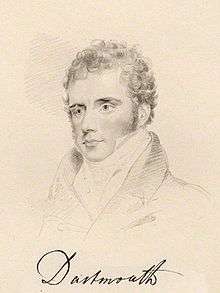William Legge, 4th Earl of Dartmouth

William Legge, 4th Earl of Dartmouth FRS, SA (29 November 1784 – 22 November 1853), styled The Honourable William Legge until 1801 and Viscount Lewisham between 1801 and 1810, was a British peer.
Background
Dartmouth was the son of George Legge, 3rd Earl of Dartmouth, by Lady Frances, daughter of Heneage Finch, 3rd Earl of Aylesford. Heneage Legge and Arthur Legge were his younger brothers.[1]
Career
Dartmouth was returned to Parliament as one of two representatives for Milborne Port at a by-election in January 1810.[2] However, in November of the same year he succeeded his father in the earldom and took his seat in the House of Lords.[3] He was admitted a Fellow of the Royal Society on 7 November 1822.[4] He was also a Fellow of the Society of Antiquaries.[1]
Family
Lord Dartmouth was twice married.[1]
He married firstly Lady Frances Charlotte, daughter of Charles Chetwynd-Talbot, 2nd Earl Talbot, on 5 April 1820. They had one son:
- William Walter, 5th Earl of Dartmouth, b. 12 August 1824
Lady Frances died on 4 October 1823.
Lord Dartmouth married secondly the Honourable Frances, daughter of Reverend George Barrington, 5th Viscount Barrington, on 25 October 1828. They had six sons and nine daughters. His children by his second wife were:
- Frances Elizabeth b c1830,
- Louisa b c1831,
- George Barrington b 19 December 1831,
- Beatrix Maria b c1833,
- Edward Henry b 23 April 1834,
- Arthur Kaye Howard b c1835,
- Katharine b c1837,
- Florence b 1838,
- Augustus b 28 November 1839,
- Barbara Caroline b 1841,
- Charles Gounter b 9 May 1842,
- Charlotte Anne Georgiana b c1844,
- Heneage b 3 July 1845,
- Harriet Octavia b 1 March 1847,
- Wilhelmina b 1849.
The Countess of Dartmouth died on 12 August 1849.
Lord Dartmouth remained a widower until his death in November 1853, aged 68. He was succeeded in the earldom by his only child from his first marriage,
Other
Dartmouth was the litigant in the trust law case of Howe v Earl of Dartmouth (1802) 7 Ves 137.
References
- 1 2 3 thepeerage.com William Legge, 4th Earl of Dartmouth
- ↑ The London Gazette: no. 16339. p. 178. 3 February 1810. Retrieved 19 November 2010.
- ↑ leighrayment.com House of Commons: Mayo to Minehead
- ↑ "Lists of Royal Society Fellows". Retrieved 2006-12-15.
External links
- Hansard 1803–2005: contributions in Parliament by the Earl of Dartmouth
| Parliament of the United Kingdom | ||
|---|---|---|
| Preceded by Hugh Leycester Lord Paget |
Member of Parliament for Milborne Port January–November 1810 With: Hugh Leycester |
Succeeded by Hugh Leycester Hon. Sir Edward Paget |
| Peerage of Great Britain | ||
| Preceded by George Legge |
Earl of Dartmouth 1810–1853 |
Succeeded by William Legge |